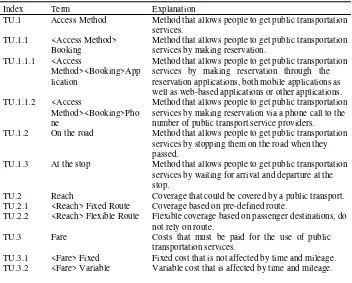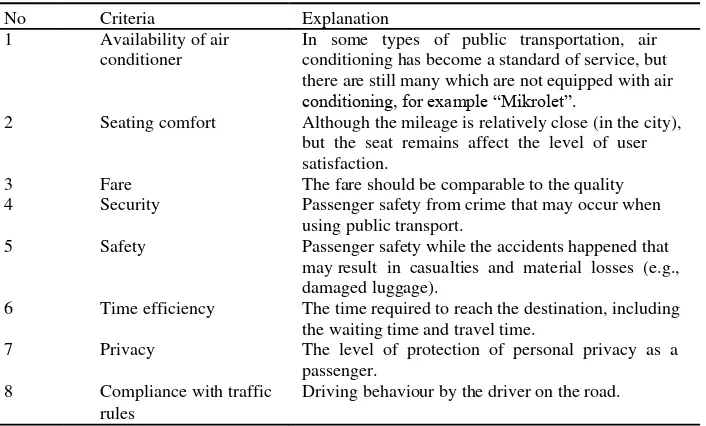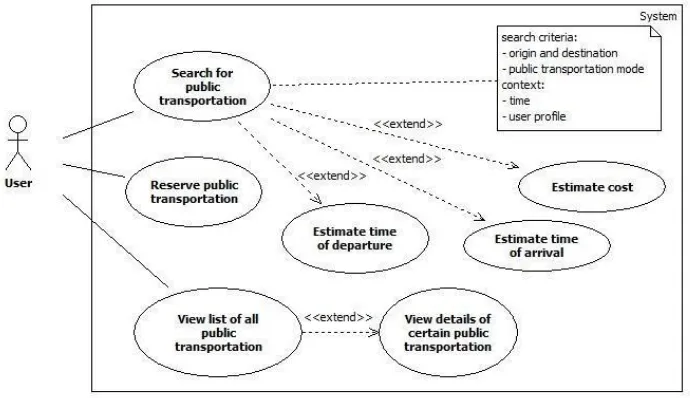Volume 2, Number 2, 2017, pp. 92-102
Journal Homepage: www.jitecs.ub.ac.id
Design of REST API for LocalPublic Transportation Information Services in
Malang City
Agi Putra Kharisma
1, Aryo Pinandito
2Dept. Informatic/Computer Sicene, Faculty of Computer Science, University of Brawijaya Veteran Road. 8, 65145 Malang, Indonesia
1
[email protected], 2[email protected]
Received 15 March 2017; accepted 22 June 2017
Abstract.
Utilization of information technology in the field of public
transportation has been proven in improving the quality of public
transportation services. The availability of information technology that
supports public transportation in Malang city is still limited. An effort is
required to encourage the availability of information technology that
support public transportation in Malang city. This research attempts to
propose a draft proposal of REST API designed for supporting
information about public transportation services in Malang city. The
result of this research showed that the REST API should provide a
search facility to find proper service mode of transportation, cost
estimation, time estimation, calling or booking a public transportation, a
list of all the modes of transportation that exist, as well as detailed
information on a mode of transport in which includes the name of public
transportation, index of comfortability, index of security, index of
safety, index of privacy, index of availability, index of accessibility
index, and route.
1
Introduction
Internet usage in Indonesia increased significantly since 2009 [1]. Based on data from the World Bank, the percentage of Internet users in Indonesia has increased from 6.9% in 2009 to 17.1% in 2014 [1]. It showed an increase of more than double in 5 years. This increase cannot be separated from the ever-expanding reach of the Internet in the Indonesian region in 2013 and estimated to have covered 22% of Indonesia at that time
[2].
Thus, the use of Internet technology in Indonesia is becoming increasingly
promising in the future. Internet as an important part of information technology has
been utilized in various fields, including transportation. For example, use of
information technology in the field of public transportation has been proven in
improving the quality of public transportation, it can be known through the state of
transportation in London city, England [3].
means of transportation has an influence on economic growth. One study that addressed this is research on the influence of the city's transportation to the city's economic growth
[4].
Currently the public transportation in Malang city is dominated by “Angkutan
Kota” or “Angkot” (public tran
sportation) or local citizens in Malang city is often
called it as “Mikrolet”. The existence of local public transportation has been perceived
benefits for the citizens, but due to several factors, among others, related to the decline
in economic conditions of citizens and the quality of transport services to the city and
the availability of alternative transportation more affordable, resulting in the amount
of demand for public transportation in Malang city decreased so that the people tend
to switch to the mode of personal transportation [5]. Such conditions contribute to the
occurrence of an increase in traffic congestion in Malang city. Thus, the need for
evaluation and improvement of transport services in Malang city for the use of local
public transportation is one part of the strategy in a solution to overcome the problem
of traffic congestion in Malang city [6] which will eventually become a factor driving
the growth of the economy of Malang city.
Based on the observations that have been made, the availability of information
technologies that support public transportation services in Malang city is still not
sufficient. For example, people are still difficult to find suitable public transport for
him/her. This is due to the limitations of information systems that are currently
available. On the other hand, the process of determining a suitable public
transportation used by the user is not just a process of finding an appropriate route
because public transportation has some complex characteristics. In using public
transport, people have a variety of criteria, wherein the criteria will affect the level of
satisfaction with the decisions taken by the users of public transport. Some of criteria
include availability of air conditioning, seating comfort price/tariff, security, time
efficiency, privacy, and compliance with traffic rules [7].
Utilization of information technology in the transportation sector can be developed
through the concept of CPS (Cyber-Physical Systems). In 2010, CPS rank high on the
priority of federal research investment research in the United States [8]. One
implementation of CPS for the transportation sector is a T-CPS (Transportation CPS)
in the form of service-oriented architecture that includes perception, communication,
computing, control and service, as well as functions that corresponds to [9]. T-CPS is
an important research that leads to an availability of future intelligent transportation
systems that can be used to deliver solutions that support technology to overcome the
problems of traffic and transportation that occurs in the present [9]. It can be
concluded that information technology, in this case the service-oriented architecture,
has great potential to be implemented in the transportation sector.
2
Related Work
Yongfu [9] researched a method of a merger between the real system (physical) and virtual systems (cyber) to solve the traffic problems. The method was named T-CPS and stems from the main idea to send information about the physical objects of transportation along with state of the real system into the virtual system then integrates the virtual component with the real component via computing technology, communication, and control to realize the communication of information, coordination system and control of optimal decision making based on the interaction and feedback between the real system to a virtual system based on the object of accurate cognition of real transportation. T-CPS was developed based on service-oriented architecture [9].
In another study, Western [10] revealed major issues along with the direction of
development of the use of information technology in transportation. Issues addressed
by the Western include: the use of web technology, particularly with respect to real
time technologies such as "zero-latency" and push technology; mobile computing;
virtual reality; and the explosion of consumer electronics products. Other issues were
also highlighted by Western is the issue of data sharing and interoperability. The issue
of data sharing of such as the transport of data management, exchange and sharing the
data sets of transportation. Issues on interoperability include systems integration,
standard rules, as well as an early example of interoperability in transport.
One of the fundamental aspects of the problem are the geographical and
topographical data modelling on the public transport network. This has been
investigated in the article entitled "Modelling a Public Transport Network for
Generation of Schematic Maps and Location Queries" [11]. More than just data
modelling, in these writings, Avelar [11] has made visualization tools as well as a
prototype system that allows users to perform queries against the transport network.
From a different viewpoint, the paradigm of machine-to-machine communication
(M2M) is an important part of the internet of things (IoT) in which there is interaction
data exchange between machines with sensors. Its main objective is to build a
world-scale intelligent systems that involve interaction between machines without requiring
interaction with humans. If the mechanism of this interaction is standardized (e.g.
With REST API), it can facilitate the realization of these objectives [12].
3
Requirement Analysis
3.1
Domain Analysis
generalization. The model depicted in feature diagram such as in figure 1 with a
detailed explanation in table 1.
Fig. 1. Feature Model of Generalized Public Transportation in Malang City
Table 1. Terminology Dictionary of Generalized Public Transportation in Malang City Feature Model (figure 1)
Index Term Explanation
TU.1 Access Method Method that allows people to get public transportation services.
TU.1.1 <Access Method> Method that allows people to get public transportation Booking services by making reservation.
TU.1.1.1 <Access Method that allows people to get public transportation Method><Booking>App services by making reservation through the lication reservation applications, both mobile applications as
well as web-based applications or other applications. TU.1.1.2 <Access Method that allows people to get public transportation
Method><Booking>Pho services by making reservation via a phone call to the ne number of public transport service providers. TU.1.2 On the road Method that allows people to get public transportation
services by stopping them on the road when they passed.
TU.1.3 At the stop Method that allows people to get public transportation services by waiting for arrival and departure at the stop.
TU.2 Reach Coverage that could be covered by a public transport. TU.2.1 <Reach> Fixed Route Coverage based on pre-defined route.
TU.2.2 <Reach> Flexible Route Flexible coverage based on passenger destinations, do not rely on route.
TU.3 Fare Costs that must be paid for the use of public transportation services.
TU.4 Schedule Schedule of public transport services. TU.4.1 <Schedule> Scheduled Service time predetermined. TU.4.1.1 <Schedule> Departure time.
<Scheduled> Depart
TU.4.1.2 <Schedule> Time of arrival. <Scheduled> Arrive
TU.4.2 <Schedule> Service time not determined. Unscheduled
TU.4.2.1 <Schedule> Estimation of departures and arrivals time on public <Unscheduled> transport services which unscheduled
Estimated Operating Hours
3.2
User Satisfaction Criteria and Factors Affecting Selection of Public
Transportation Mode
User satisfaction of public transportation services in Malang city can be affected by several criteria [7] as shown in table 2. While the factors that can influence decision making in the selection of public transportation modes [13] [14] can be seen in table 3.
Table 2. User Satisfaction Criteria
No Criteria Explanation
1 Availability of air In some types of public transportation, air conditioner conditioning has become a standard of service, but
there are still many which are not equipped with air conditioning, for example “Mikrolet”.
2 Seating comfort Although the mileage is relatively close (in the city), but the seat remains affect the level of user satisfaction.
3 Fare The fare should be comparable to the quality 4 Security Passenger safety from crime that may occur when
using public transport.
5 Safety Passenger safety while the accidents happened that may result in casualties and material losses (e.g., damaged luggage).
6 Time efficiency The time required to reach the destination, including the waiting time and travel time.
7 Privacy The level of protection of personal privacy as a passenger.
8 Compliance with traffic Driving behaviour by the driver on the road. rules
Table 3. Factors Affecting Selection of Public Transportation Mode
No Factor Explanation
1 Travel expense The people generally prefer a mode of transportation with relatively low cost.
2 Travel time The people generally prefer a mode of transportation that has the shortest travel time.
especially time of arrival. For instance, modes of transport with a midnight arrival time may not be too interested.
4 Walking time The people generally prefer a mode of transportation that can be reached easily without requiring a lot of walking.
5 Accessibility The people generally prefer a mode of transportation that is easily accessible.
6 Age The age factor shown to affect the decision of the selection of the mode of transportation used. 7 Gender Gender factor also been shown to affect the selection
of the mode of transportation.
3.3
Functional RequirementsBased on the analysis of current conditions, the results of the generalization modelling to public transport in Malang city, user satisfaction criteria and factors affecting selection of public transportation mode, as well as the potential of existing information technology, then it can be derived to functional requirements of the proposed system. The proposed list of functional requirements can be seen in figure 2. Explanation in more detail about each proposed functional requirement can be seen in table 4.
Fig. 2. Functional Requirements of Proposed System
Table 4. Description of Functional Requirements of Proposed System
Code Requirement Description
9
8
JITeCS Volume 2, Number 2, 2017, pp 92-102
destination (arrival). Users can restrict the search based on certain desired type of transportation. Result of public transport can be influenced by the context prevailing at the time of the search process carried out public transportation. That context is the time, i.e. the time when the search is done, e.g. morning, afternoon, evening, night, or refer to a specific date and time) and passenger profiles, namely gender and age. In addition, the search results may represent a direct trip to the destination or the journey that requires a transfer from one mode to another mode to arrive at the destination.
KF-02 Estimate time of Users can use this system to estimate the time of departure departure. This functionality can also be translated
that the system can provide an estimate of when public transportation is available to passengers in accordance with the position. For example, when people want to use transport facilities “Bus Halokes”, the system can provide an estimate of the appropriate departure from the place where the passenger will rise. Another example, when people book a taxi, the system can provide an estimate of the arrival of the taxi the place where passengers will rise.
KF-03 Estimate time of arrival Users can use this system to estimate the time of arrival at the destination.
KF-04 Estimate cost Users can use this system to estimate the costs needed to get to a location using public transportation. KF-05 Reserve public Users can place an order for public transport services.
transportation Reservations can be through phone calls and applications from third parties.
KF-06 View list of all public Users can see the names of all public transport modes transportation available in Malang city.
KF-07 View details of certain Users can view a detailed explanation of certain public transportation public transport. The detailed explanations include
the name of public transportation, index of comfortability, index of security, index of safety, index of privacy, index of availability, index of accessibility index, and route.
4
REST API Design
design of REST API on this research has focused on functional requirements and does not
include navigation feature among resources. So, that is not yet meet one of REST
principle, i.e. hypertext as the engine of application state (HATEOAS).
Table 5. Proposed REST API
REST Target URI Description
Method
Retrieve /search/<origin>/<destinat Displays a list of public transportation that can be ion> used from an origin to a specific destination. Sample
response in XML: <search-result>
<result>
<name>Mikrolet ABB</name>
<origin>-7.9684824, 112.6510309</origin> <destination>
-7.9725709, 112.6439776 </destination>
<name>Mikrolet CKL</name>
<origin>-7.9725709, 112.6439776</origin> <destination>
-7.967269, 112.638688 </destination>
<name>Mikrolet HA</name>
<origin>-7.967269, 112.638688</origin> <destination>
-7.983857, 112.631265 </destination>
</result> <result>
<name>Mikrolet ABB</name>
<origin>-7.9684824, 112.6510309</origin> <destination>
-7.983857, 112.631265 <destination>
<name>Mikrolet AH</name>
<origin>-7.983857, 112.631265</origin> <destination>
-7.983857, 112.631265 </destination>
</result> <result>
<name>Taksi Citra</name>
<origin>-7.9684824, 112.6510309</origin> <destination>
-7.983857, 112.631265 </destination>
</result> </search-result>
Retrieve /search/<origin>/<destinat Displays the estimated costs to be paid. Sample ion>/<name response in XML:
100
JITeCS Volume 2, Number 2, 2017, pp 92-102
Retrieve
Activity
/search/<origin>/<destinat
ion>/<name>/departure-ar
rival-estimation
/reserve/<name>
<name>Mikrolet ABB</name>
<origin>-7.9684824, 112.6510309</origin> <destination>
-7.9725709, 112.6439776 </destination>
<cost-estimation>4000</cost-estimation> </cost-estimation>
Displays the estimated time of departure and arrival
times. Sample response in XML: <departure-arrival-estimation>
<name>Mikrolet ABB</name>
<origin>-7.9684824, 112.6510309</origin> <destination>
-7.9725709, 112.6439776 </destination>
<departure-estimation> 2005-08-15T15:52:01+00:00 </departure-estimation> <arrival-estimation>
2005-08-15T16:10:01+00:00 </arrival-estimation>
</departure-arrival-estimation> <departure-arrival-estimation>
<name>Mikrolet ABB</name>
<origin>-7.9684824, 112.6510309</origin> <destination>
-7.9725709, 112.6439776 </destination>
<departure-estimation> 2005-08-15T16:10:01+00:00 </departure-estimation> <arrival-estimation>
2005-08-15T16:25:01+00:00 </arrival-estimation>
</departure-arrival-estimation> <departure-arrival-estimation>
<name>Mikrolet ABB</name>
<origin>-7.9684824, 112.6510309</origin> <destination>
-7.9725709, 112.6439776 </destination>
<departure-estimation> 2005-08-15T17:00:01+00:00 </departure-estimation> <arrival-estimation>
2005-08-15T17:45:01+00:00 </arrival-estimation>
</departure-arrival-estimation>
Doing calling or booking the mode of transport. Sample response in XML:
<reservation>
<phone>0341-490555</phone> <phone>0341-404040</phone> <application>
http://reservasitaksicitra.com </application>
<application>
http://taksi-online.com </application>
</reservation>
Retrieve /public-transportations Displays a list of all existing public transportation modes. Sample response in XML:
<transportation-mode> <name>Mikrolet HA</name> <name>Mikrolet ABB</name> <name>Taksi Citra</name> </transportation-mode>
Retrieve /public-transportations/<n Displays detailed information of a certain public ame> transportation mode. Sample response in XML:
<public-transportation-detail> <name>Mikrolet AH</name>
<comfortability-index>3</comfortability-index> <security-index>3</security-index >
<safety-index>3</safety-index> <privacy-index>2</privacy-index>
<availability-index>4.1</availability-index> <route>
<leave>A, B, C, D</leave> <return>D, F, F, A</return> </route>
</public-transportation-detail>
5
Conclusion and Future Work
102
JITeCS Volume 2, Number 2, 2017, pp 92-102
References
1. World Bank.: Internet User (Per 100 People), http://data.worldbank.org/
indicator/IT.NET.USER.P2 (2016)
2. Huawei.: Indonesia XL DM project, https://intouch.huawei.com/bme/ partnership/cooperation_detail_en.jsp?targetPage=1&objectId=1
00404 (2013)
3. Forbes.: How Big Data And The Internet Of Things Improve Public Transport In London, http://www.forbes.com/sites/bernardmarr/2015/05/27/how-big-da ta-and-the-internet-of-things-improve-public-transport-in-lon don (2015)
4. Rahmasari, Fitri Hardianti., Aisyah, Arini Natasya., Wilandari, Anindita.,
Kusumawardani, Diaz.: Pengaruh Transportasi Kota Terhadap Pertumbuhan Ekonomi Kota. Institut Teknologi Sepuluh Nopember (2013)
5. Julia, Andres W.: Analisis Kinerja Angkutan Kota di Kota Malang (Studi Kasus Trayek Hamidrusdi-Mergan-Landungsari). Universitas Negeri Malang (2012)
6. Ekawati, Natalia Niken., Saleh Soeaidy, Mochammad. & Ribawanto, Heru.: Kajian Dampak Pengembangan Pembanguna Kota Malang Terhadap Kemacetan Lalu Lintas (Studi pada Dinas Perhubungan Kota Malang). Universitas Brawijaya (2014)
7. Nugraha, Fransiskus Asisi Andi.: Analisis Faktor-Faktor Penyebab Turunnya Minat Penumpang Angkutan Kota Di Terminal Ubung Dengan Metode Analytic Hierarchy Process. Universitas Atma Jaya Yogyakarta (2011)
8. Marburger, John H., Kvamme, E. F., Scalise, George. & Reed, Daniel A.: Leadership Under Challenge: Information Technology R&D in a Competitive World. An Assessment of the Federal Networking and Information Technology R&D Program. Washington DC. (2007) 9. Yongfu, Li., Dihua, Sun., Weining, Liu. & Xuebo Zhang.: A Service-Oriented Architecture
for the Transportation Cyber-Physical Systems. Proceedings of the 31st Chinese Control Conference July 25-27, 2012, Hefei, China. (2012)
10. Western, Jeffrey L., & Ran, Bin.: Information Technology in Transportation - Key Issues and a Look Forward, http://onlinepubs.trb.org/Onlinepubs/
millennium/00054.pdf (2000)
11. Avelar, Silvania & Huber, Raphael. Modeling a Public Transport Network for Generation of Schematic Maps and Location Queries. Institute of Cartography, ETH Zurich. 12. Elmangoush, Asma., Magedanz, Thomas., Blotny, Alexander., Blum, Niklas.: Design of
REST APIs for M2M Services. In: 16th International Conference on Intelligence in Next Generation Networks, pp. 50–56. IEEE Press, New York (2012)
13. Sugianto, Gito.: Model Pemilihan Moda dan Perbandingan Perilaku Perjalanan (Studi Kasus Di Yogyakarta dan Filipina). Konferensi Nasional Teknik Sipil 7 (KoNTekS 7), Universitas Sebelas Maret (UNS), Surakarta (2013)



